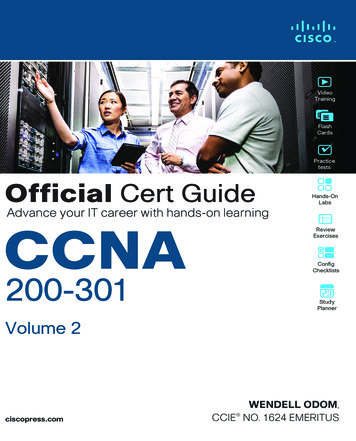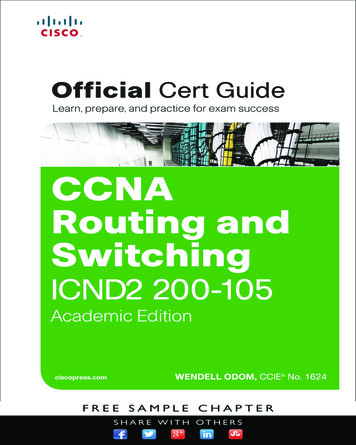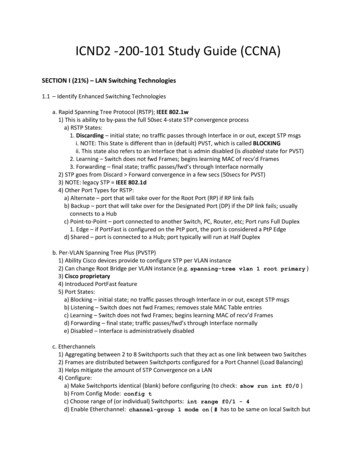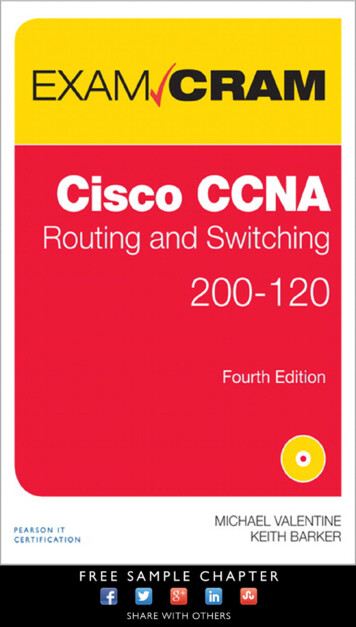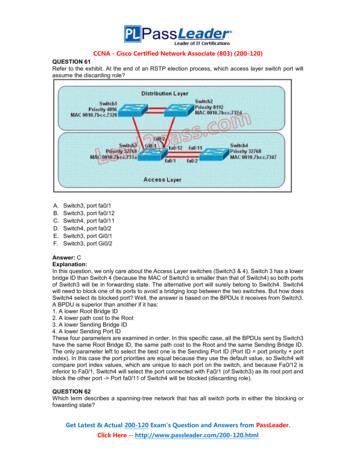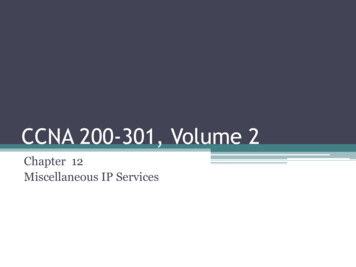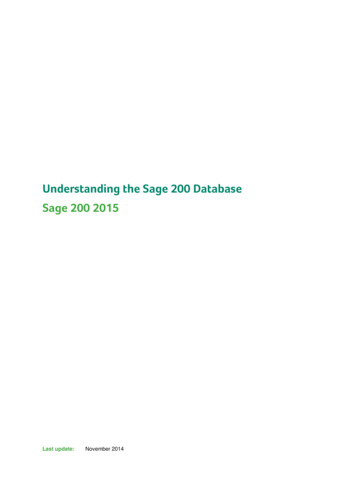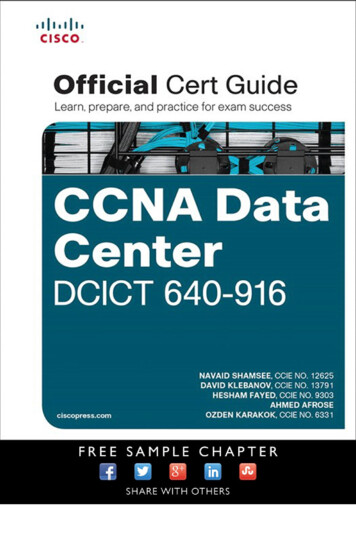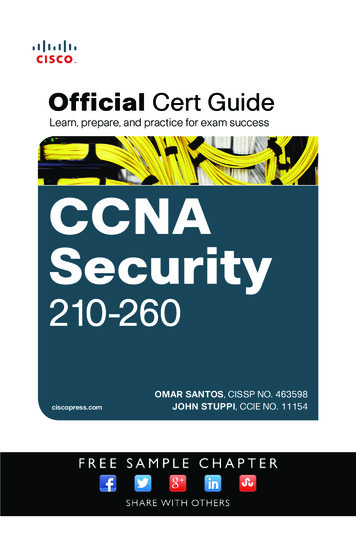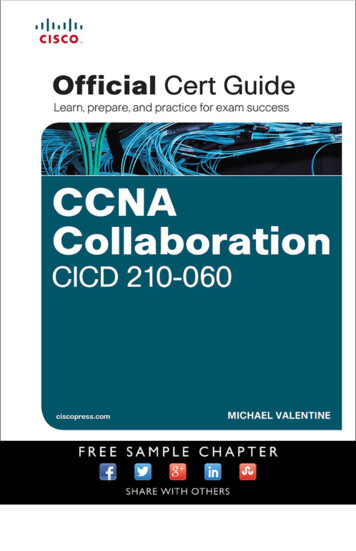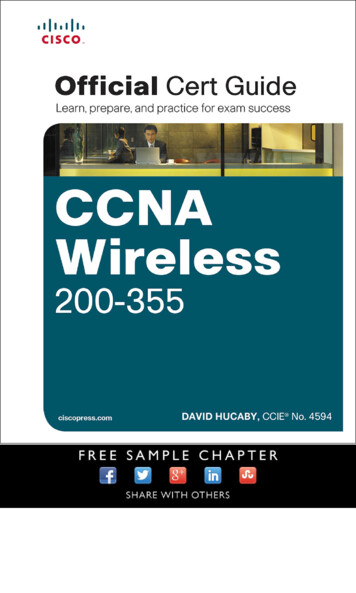
Transcription
CCNAWireless200-355Official Cert GuideDAVID HUCABY, CCIE NO. 4594Cisco Press800 East 96th StreetIndianapolis, IN 46240
iiCCNA Wireless 200-355 Official Cert GuideCCNA Wireless 200-355 Official Cert GuideDavid HucabyCopyright 2016 Pearson Education, Inc.Published by:Cisco Press800 East 96th StreetIndianapolis, IN 46240 USAAll rights reserved. No part of this book may be reproduced or transmitted in any form or by any means,electronic or mechanical, including photocopying, recording, or by any information storage and retrievalsystem, without written permission from the publisher, except for the inclusion of brief quotations in areview.Printed in the United States of AmericaFirst Printing December 2015Library of Congress Control Number: 2015955570ISBN-13: 978-1-58714-457-8ISBN-10: 1-58714-457-3Warning and DisclaimerThis book is designed to provide information about preparing for the CCNA Wireless 200-355 exam.Every effort has been made to make this book as complete and as accurate as possible, but no warrantyor fitness is implied.The information is provided on an “as is” basis. The authors, Cisco Press, and Cisco Systems, Inc. shallhave neither liability nor responsibility to any person or entity with respect to any loss or damagesarising from the information contained in this book or from the use of the discs or programs that mayaccompany it.The opinions expressed in this book belong to the author and are not necessarily those ofCisco Systems, Inc.Trademark AcknowledgmentsAll terms mentioned in this book that are known to be trademarks or service marks have been appropriately capitalized. Cisco Press or Cisco Systems, Inc., cannot attest to the accuracy of this information.Use of a term in this book should not be regarded as affecting the validity of any trademark or servicemark.Special SalesFor information about buying this title in bulk quantities, or for special sales opportunities (whichmay include electronic versions; custom cover designs; and content particular to your business, training goals, marketing focus, or branding interests), please contact our corporate sales department atcorpsales@pearsoned.com or (800) 382-3419.For government sales inquiries, please contact governmentsales@pearsoned.com.For questions about sales outside the U.S., please contact international@pearsoned.com.
iiiFeedback InformationAt Cisco Press, our goal is to create in-depth technical books of the highest quality and value. Each bookis crafted with care and precision, undergoing rigorous development that involves the unique expertiseof members from the professional technical community.Readers’ feedback is a natural continuation of this process. If you have any comments regarding how wecould improve the quality of this book, or otherwise alter it to better suit your needs, you can contact usthrough email at feedback@ciscopress.com. Please make sure to include the book title and ISBN in yourmessage.We greatly appreciate your assistance.Publisher: Paul BogerAssociate Publisher: Dave DusthimerBusiness Operation Manager, Cisco Press: Jan CornelssenExecutive Editor: Mary Beth RayManaging Editor: Sandra SchroederSenior Development Editor: Christopher ClevelandSenior Project Editor: Tonya SimpsonCopy Editor: Bill McManusTechnical Editor: Jerome HenryEditorial Assistant: Vanessa EvansCover Designer: Mark ShirarComposition: Studio GalouIndexer: Publishing WorksProofreader: Laura Hernandez
ivCCNA Wireless 200-355 Official Cert GuideAbout the AuthorDavid Hucaby, CCIE No. 4594, is a network engineer for a large university healthcarenetwork based on Cisco wireless products. David has bachelor’s and master’s degreesin electrical engineering from the University of Kentucky. He is the author of severalCisco Press titles, including CCNP SWITCH Exam Certification Guide; Cisco LANSwitching Video Mentor; CCNP Security FIREWALL Exam Certification Guide;Cisco ASA, PIX, and FWSM Firewall Handbook, Second Edition; and Cisco FirewallVideo Mentor.David lives in Kentucky with his wife, Marci, and two daughters.About the Technical ReviewerJerome Henry, CCIE Wireless No. 24750, is a technical marketing engineer in theWireless Enterprise Networking Group at Cisco systems. Jerome has close to 17 yearsof experience teaching technical Cisco courses in more than 15 different countries and 4different languages, to audiences ranging from bachelor degree students to networkingprofessionals and Cisco internal system engineers.Focusing on his wireless experience, Jerome joined Cisco in 2012. Before that time, hewas consulting and teaching Heterogeneous Networks and Wireless Integration withthe European Airespace team, which Cisco later acquired to become its main wirelesssolution. He then spent several years with a Cisco Learning Partner developing wireless courses and working on training material for new wireless technologies. In additionto his CCIE Wireless certification, Jerome is a Certified Wireless Networking Expert(CWNE No. 45) and has developed several Cisco courses focusing on wireless topics(IUWNE, IUWMS, IUWVN, CUWSS, IAUWS, LBS, CWMN lab guide, and so on) andauthored several Wireless books (CCNP Wireless IUWMS Quick Reference, CCNPWireless CUWSS Quick Reference, and so on). Jerome also is an IEEE 802.11 groupmember and participant of Wi-Fi Alliance working groups. With more than 10,000 hoursin the classroom, Jerome was awarded the IT Training Award Best Instructor silver medalin 2009. He is based in the Research Triangle Park in North Carolina.
DedicationsDedicationsAs always, this book is dedicated to the most important people in my life: my wife,Marci, my two daughters, Lauren and Kara, and my parents, Reid and Doris Hucaby.Their love, encouragement, and support carry me along. I’m so grateful to God, whogives endurance and encouragement (Romans 15:5), who has allowed me to enjoy networking and working on projects like this, and who invented wireless communication.With a higher purpose.As the sign in front of a church near my home says: “Prayer: The world’s greatest wireless connection.”v
viCCNA Wireless 200-355 Official Cert GuideAcknowledgmentsIt has been my great pleasure to work on another Cisco Press project. I’ve now beenwriting Cisco Press titles continuously for more than 15 years. I have physically worn outseveral laptop keyboards and probably several Cisco Press editors in the process. I ammost thankful that Chris Cleveland has never worn out—he has been the developmenteditor for almost every project I have ever worked on. I can’t say enough good thingsabout working with him. I am grateful to Mary Beth Ray for inviting me back to revisethis book, Tonya Simpson as the project editor, Bill McManus for raising the copyediting bar to an amazing height, and many other Cisco Press folks who have workedhard to make this book happen.I am very grateful for the insight, knowledge, and helpful comments that JeromeHenry has provided. He is a tremendous resource for wireless networking expertiseand training. Jerome’s input has made this a more well-rounded book and me a moreeducated author.As always, I have enjoyed the good discussions with my dad, Reid Hucaby, a fellow EEand a seasoned RF engineer, that this book has prompted about all things wireless.Finally, I am indebted to my co-worker and good friend, Rick Herring, who has beensaying for years that I should write a wireless book one day. I always thought he wasjoking until now.
Contents at a GlanceContents at a GlanceIntroductionxxiChapter 1:RF Signals and Modulation3Chapter 2:RF StandardsChapter 3:RF Signals in the Real WorldChapter 4:Understanding AntennasChapter 5:Wireless LAN TopologiesChapter 6:Understanding 802.11 Frame TypesChapter 7:Planning Coverage with Wireless APsChapter 8:Understanding Cisco Wireless ArchitecturesChapter 9:Implementing Autonomous and Cloud DeploymentsChapter 10:Implementing Controller-based DeploymentsChapter 11:Understanding Controller DiscoveryChapter 12:Understanding RoamingChapter 13:Understanding RRMChapter 14:Wireless Security FundamentalsChapter 15:Configuring a WLANChapter 16:Implementing a Wireless Guest NetworkChapter 17:Configuring Client ConnectivityChapter 18:Managing Cisco Wireless NetworksChapter 19:Dealing with Wireless InterferenceChapter 20:Troubleshooting WLAN ConnectivityChapter 21:Final 9429449475Appendix A: Answers to the “Do I Know This Already?” QuizzesAppendix B:Modulation and Coding Schemes505Appendix C: CCNA Wireless 200-355 Exam UpdatesKey Terms GlossaryIndex529On the DVDAppendix D: Study PlannerKey Terms Glossary211515513487vii
viiiCCNA Wireless 200-355 Official Cert GuideContentsIntroductionChapter 1xxiRF Signals and Modulation3“Do I Know This Already?” QuizFoundation Topics37Comparing Wired and Wireless NetworksUnderstanding Basic Wireless TheoryUnderstanding FrequencyUnderstanding Phase77914Measuring Wavelength14Understanding RF Power and dB15Important dB Laws to Remember17Comparing Power Against a Reference: dBm19Measuring Power Changes Along the Signal PathUnderstanding Power Levels at the ReceiverCarrying Data Over an RF SignalFHSS26DSSS271-Mbps Data Rate282-Mbps Data Rate285.5-Mbps Data Rate2911-Mbps Data Rate30OFDM30Modulation SummaryExam Preparation TasksReview All Key TopicsKey TermsChapter 232343434RF Standards37“Do I Know This Already?” QuizFoundation Topics41Regulatory Bodies41ITU-R2441FCC42ETSI44Other Regulatory Bodies45372320
ContentsIEEE Standards Body802.11 Channel Use4547Channels in the 2.4-GHz ISM Band47Channels in the 5-GHz U-NII BandsIEEE 802.11 .11n54495051Channel Aggregation55Spatial Multiplexing57MAC Layer Efficiency58Transmit Beamforming59Maximal-Ratio Combining60802.11n Modulation and Coding Schemes802.11ac60Robust Channel AggregationDense Modulation6163MAC Layer Efficiency63Explicit Transmit BeamformingScalable MIMO64Multi-user MIMO64802.11ac Implementation65802.11 in Other Frequency BandsWi-Fi AllianceReview All Key Topics6868802.11 Protocol SummaryDefine Key Terms6869RF Signals in the Real World“Do I Know This Already?” QuizFoundation TopicsInterference6566Exam Preparation TasksChapter 36471717474Co-Channel Interference74Neighboring Channel InterferenceNon-802.11 Interference767560ix
xCCNA Wireless 200-355 Official Cert GuideFree Space Path Loss 77Mitigating the Effects of Free Space Path LossEffects of Physical n83Diffraction84Fresnel Zones84Exam Preparation TasksReview All Key TopicsDefine Key TermsChapter 48081888888Understanding Antennas91“Do I Know This Already?” QuizFoundation Topics94Antenna CharacteristicsRadiation PatternsGain949497Beamwidth97Polarization98Antenna Types99Omnidirectional AntennasDirectional AntennasAntenna Summary99103107Adding Antenna AccessoriesExam Preparation TasksReview All Key TopicsDefine Key TermsChapter 591107109109109Wireless LAN Topologies111“Do I Know This Already?” QuizFoundation Topics114Types of Wireless NetworksWireless LAN TopologiesBasic Service Set111114115116Distribution SystemExtended Service Set118120Independent Basic Service Set12279
ContentsOther Wireless TopologiesRepeater122Workgroup BridgeOutdoor BridgeMesh Network123124125Exam Preparation TasksReview All Key TopicsDefine Key TermsChapter 6122126126126Understanding 802.11 Frame Types“Do I Know This Already?” QuizFoundation Topics132802.11 Frame Format132802.11 Frame Addressing134Accessing the Wireless MediumCarrier Sense802.11 Frame Types137140Management FramesControl Frames140141142Client Housekeeping142A Client Scans for APsA Client Joins a BSSA Client Leaves a BSS143144145A Client Moves Between BSSsA Client Saves Power147Exam Preparation Tasks151Review All Key TopicsDefine Key TermsChapter 7136137Collision AvoidanceData Frames146151151Planning Coverage with Wireless APs“Do I Know This Already?” QuizFoundation TopicsAP Cell Size129129153153157157Tuning Cell Size with Transmit PowerTuning Cell Size with Data Rates159157xi
xiiCCNA Wireless 200-355 Official Cert GuideAdding APs to an ESS162The Roaming Process163WLAN Channel Layout165Designing and Validating Coverage with Site SurveysApplications and Their RequirementsSite Survey Types and Tools174Active Site Surveys175169171Predictive or Planning SurveysPassive Site Surveys172Developing a Complete Survey StrategyExam Preparation Tasks178180Review All Key TopicsDefine Key Terms180180Site Survey Type and Application HighlightsChapter 8180Understanding Cisco Wireless Architectures“Do I Know This Already?” QuizFoundation Topics183187Autonomous Architecture187Cloud-based Architecture190Split-MAC Architectures192Centralized Wireless Network Architecture197Converged Wireless Network Architecture200FlexConnect Wireless Network ArchitectureCisco Wireless Network Building BlocksCisco Wireless LAN Controllers204205205206Exam Preparation Tasks209Review All Key TopicsChapter 9183187Distributed ArchitecturesCisco APs169209Implementing Autonomous and Cloud Deployments“Do I Know This Already?” QuizFoundation Topics211214Initially Configuring an Autonomous APConnecting the AP215Initially Configuring the AP217Upgrading an Autonomous AP221215211
ContentsInitially Configuring Cloud-based APsExam Preparation Tasks228Review All Key TopicsDefine Key TermsChapter 10223228228Implementing Controller-based Deployments“Do I Know This Already?” QuizFoundation Topics231231235Connecting a Centralized ControllerUsing Controller Ports235235Using Controller InterfacesPerforming an Initial Setup237238Initial Setup of a Centralized Controller with the ConfigurationWizard 239Initial Setup of a Converged Controller with the ConfigurationWizard 247Initial Setup of a Centralized Controller with WLAN Express SetupInitial Setup of a Centralized Controller with the CLIMaintaining a Wireless Controller258Backing Up Controller ConfigurationsUpdating Wireless LAN Controller Code259Updating Wireless Control Module Code262Exam Preparation Tasks263Review All Key TopicsDefine Key TermsChapter 11258263263Understanding Controller Discovery“Do I Know This Already?” QuizFoundation Topics268Discovering a ControllerAP States265268268Discovering a WLCSelecting a WLC270271Designing High Availability272Detecting a Controller FailureBuilding Redundancy274N 1 Redundancy274N N Redundancy275N N 1 RedundancySSO Redundancy276277274265257254xiii
xivCCNA Wireless 200-355 Official Cert GuideExam Preparation Tasks279Review All Key TopicsDefine Key TermsChapter 12279279Understanding Roaming281“Do I Know This Already?” QuizFoundation Topics285Roaming Overview285281Roaming Between Autonomous APsIntracontroller Roaming285288Roaming Between Centralized ControllersLayer 2 Roaming290Layer 3 Roaming292290Scaling Mobility with Mobility Groups296Roaming Coordination with Centralized ControllersRoaming Between Converged ControllersExam Preparation Tasks303Review All Key TopicsDefine Key TermsChapter 13303303Understanding RRM305“Do I Know This Already?” QuizFoundation Topics300305308Configuring 802.11 SupportConfiguring Data Rates308309Configuring 802.11n and 802.11ac SupportUnderstanding RRM 311RF GroupsTPCDCA313315318Coverage Hole Detection MitigationManual RF ConfigurationVerifying RRM ResultsExam Preparation TasksReview All Key TopicsDefine Key TermsChapter 14320322323325325325Wireless Security Fundamentals“Do I Know This Already?” Quiz327327310298
ContentsFoundation Topics331Anatomy of a Secure ConnectionAuthentication331332Message Privacy333Message Integrity334Intrusion Protection335Wireless Client Authentication MethodsOpen TPEAP339340EAP-TLS340Wireless Privacy and Integrity MethodsTKIPCCMP336341341342WPA and WPA2342Securing Management Frames with MFPConfiguring Wireless Security343344Configuring WPA2 Personal344Configuring WPA2 Enterprise Mode346Configuring WPA2 Enterprise with Local EAPExam Preparation Tasks351Review All Key TopicsDefine Key TermsChapter 15351351Configuring a WLAN353“Do I Know This Already?” QuizFoundation TopicsWLAN Overview353355355Configuring a WLAN356Configuring a RADIUS Server356Creating a Dynamic Interface358Creating a New WLAN360Configuring WLAN SecurityConfiguring WLAN QoS362364Configuring Advanced WLAN SettingsFinalizing WLAN Configuration366365348xv
xviCCNA Wireless 200-355 Official Cert GuideExam Preparation TasksReview All Key TopicsChapter 16368368Implementing a Wireless Guest Network“Do I Know This Already?” QuizFoundation Topics374Scaling the Guest Network375Configuring a Guest Network377Exam Preparation TasksReview All Key TopicsChapter 17371374Guest Network OverviewDefine Key Terms382382382Configuring Client Connectivity“Do I Know This Already?” QuizFoundation Topics385385388Configuring Common Wireless Clients388Considering Wireless Client RequirementsUnderstanding Windows Wi-Fi395Understanding MacOS X Wi-Fi397Understanding Apple iOS Wi-Fi400Cisco Compatibility ExtensionsExam Preparation TasksReview All Key TopicsChapter 18402406406406Managing Cisco Wireless Networks“Do I Know This Already?” QuizFoundation Topics388389Understanding Android Wi-FiDefine Key Terms371409409412Cisco Unified Access OverviewUsing Prime Infrastructure412414Alarms in the Dashboard417Monitoring a Wireless Network with Prime InfrastructureUsing Prime Infrastructure MapsConfiguring Devices with PIExam Preparation TasksReview All Key Topics427427426420419
ContentsChapter 19Dealing with Wireless Interference“Do I Know This Already?” QuizFoundation Topics429432Understanding Types of InterferenceBluetoothZigBee432432433Cordless Phones434Microwave OvensWiMAX429434434Other Devices435Using Tools to Detect and Manage InterferenceSpectrum AnalyzersCisco CleanAir439Enabling CleanAir440Air-Quality Index443Using Event-Driven RRMExam Preparation TasksReview All Key TopicsDefine Key TermsChapter 20445447447447Troubleshooting WLAN Connectivity“Do I Know This Already?” QuizFoundation Topics436436449449453Troubleshooting Client ConnectivityTroubleshooting Clients from PITesting a Client from PI453454459Troubleshooting Clients from the ControllerVerifying Client WLAN SettingsViewing Controller Logs462463Troubleshooting AP Connectivity464Verifying AP-to-WLC Connectivity464Verifying AP-to-Network Connectivity465Verifying the AP and Antenna OrientationChecking the RF EnvironmentExam Preparation TasksReview All Key Topics472472461468467xvii
xviiiCCNA Wireless 200-355 Official Cert GuideChapter 21Final Review475Advice About the Exam Event475Learn the Question Types Using the Cisco Certification ExamTutorial 475Think About Your Time BudgetOther Pre-Exam Suggestions480481Exam Engine and Questions on the DVDInstall the Exam Engine482482Activate and Download the Practice ExamActivating Other ExamsPremium Edition483484Using the Exam Engine484The Cisco Learning NetworkFinal Thoughts483485485Appendix AAnswers to the “Do I Know This Already?” QuizzesAppendix BModulation and Coding SchemesAppendix CCCNA Wireless 200-355 Exam Updates505513Always Get the Latest at the Companion WebsiteTechnical ContentKey Terms GlossaryIndex528On the DVDAppendix D Study PlannerKey Terms Glossary513515513487
ContentsIcons Used in This BookWireless DeviceWireless SignalWirelessAccess PointLightweightAccess PointDirectional AntennaWireless LANControllerWireless BridgeCAPWAP TunnelCAPWAPLayer 2 SwitchMobilityServices EngineWireless CellMultilayer SwitchReal TimeLocation ServiceWireless ClientAuthenticationServiceAAAMeshAccess PointSpectrumAnalysisServerCommand Syntax ConventionsThe conventions used to present command syntax in this book are the same conventionsused in the IOS Command Reference. The Command Reference describes these conventions as follows: Boldface indicates commands and keywords that are entered literally as shown. Inactual configuration examples and output (not general command syntax), boldfaceindicates commands that are manually input by the user (such as a show command). Italic indicates arguments for which you supply actual values. Vertical bars ( ) separate alternative, mutually exclusive elements. Square brackets ([ ]) indicate an optional element. Braces ({ }) indicate a required choice. Braces within brackets ([{ }]) indicate a required choice within an optional element.xix
xxCCNA Wireless 200-355 Official Cert GuideIntroductionWelcome to the world of Cisco Certified Network Associate (CCNA) Wireless! As technology continues to evolve, wireless technologies are finding their way to the forefront.This clearly indicates the progression from a fixed wired type of connectivity to a morefluid, mobile workforce that can work when, where, and how they want. Regardless ofyour background, one of the primary goals of the CCNA Wireless certification is tointroduce you to the Cisco Unified Wireless Network (CUWN).This book is designed to help you prepare for the Cisco CCNA Wireless 200-355WIFUND (Implementing Cisco Wireless Networking Fundamentals) certification exam.To achieve the CCNA Wireless specialization, you must first pass the CCENT, CCNARouting and Switching, or any CCIE certification.Who Should Read This BookWireless networking is a complex business. The CCNA Wireless specialization wasdeveloped to introduce wireless LANs, the CUWN, and Cisco’s wireless product line.The certification tests for proficiency in designing, installing, configuring, monitoring,and troubleshooting wireless networks in an enterprise setting.How to Use This BookThe book consists of 21 chapters. Each chapter tends to build upon the chapter thatprecedes it. The chapters of the book cover the following topics: Chapter 1, “RF Signals and Modulation”: This chapter covers the basic theorybehind radio frequency (RF) signals and the methods used to carry data wirelessly. Chapter 2, “RF Standards”: This chapter covers the agencies that regulate, standardize, and validate the correct use of wireless LAN devices. Chapter 3, “RF Signals in the Real World”: This chapter explores many of theconditions that can affect wireless signal propagation. Chapter 4, “Understanding Antennas”: This chapter explains some basic antennatheory, in addition to various types of antennas and their application. Chapter 5, “Wireless LAN Topologies”: This chapter explains the topologies thatcan be used to control access to the wireless medium and provide data exchangebetween devices. Chapter 6, “Understanding 802.11 Frame Types”: This chapter covers theframe format and frame types that APs and clients must use to communicatesuccessfully. It also discusses the choreography that occurs between an AP and itsclients. Chapter 7, “Planning Coverage with Wireless APs”: This chapter explains howwireless coverage can be adjusted to meet a need and how it can be grown to scaleover a greater area and a greater number of clients. It also explains how coveragecan be measured, surveyed, and validated.
Introduction Chapter 8, “Understanding Cisco Wireless Architectures”: This chapterdescribes the autonomous, cloud-based, centralized, and converged wireless architectures and how you can leverage their respective strengths to solve some fundamental problems. Chapter 9, “Implementing Autonomous and Cloud Deployments”: This chapterdiscusses basic operation of an autonomous AP and how you can connect to it andconvert it to lightweight mode, to become a part of a larger, more integrated wireless network. It also provides an introduction of Cisco Meraki cloud-based APs. Chapter 10, “Implementing Controller-based Deployments”: This chapter covers the wireless controller’s role in linking wired and wireless networks. It also coversthe minimal initial configuration needed to get a controller up on the network whereyou can manage it more fully. Chapter 11, “Understanding Controller Discovery”: This chapter explains theprocess that each lightweight AP must go through to discover and bind itself with acontroller before wireless clients can be supported. Chapter 12, “Understanding Roaming”: This chapter discusses client mobilityfrom the AP and controller perspectives so that you can design and configure yourwireless network properly as it grows over time. Chapter 13, “Understanding RRM”: This chapter covers Radio ResourceManagement (RRM), a flexible and automatic mechanism that Cisco wireless LANcontrollers can use to make wireless network operation more efficient. Chapter 14, “Wireless Security Fundamentals”: This chapter covers many of themethods you can use to secure a wireless network. Chapter 15, “Configuring a WLAN”: This chapter explains how to define andtune a wireless LAN to support wireless clients and connectivity with a wired infrastructure. Chapter 16, “Implementing a Wireless Guest Network”: This chapter discussesthe steps you can take to configure a guest network as an extension to your wirelessinfrastructure. Chapter 17, “Configuring Client Connectivity”: This chapter introduces someof the most common types of wireless clients and how to configure them to join awireless LAN. Chapter 18, “Managing Cisco Wireless Networks”: This chapter provides anoverview of Prime Infrastructure, how you can configure controllers and APs withit, and how you can use it to monitor a variety of things in your network. Chapter 19, “Dealing with Wireless Interference”: This chapter covers somecommon types of devices that can cause interference and the Cisco CleanAir features that can detect and react to the interference sources.xxi
xxiiCCNA Wireless 200-355 Official Cert Guide Chapter 20, “Troubleshooting WLAN Connectivity”: This chapter helps youget some perspective about wireless problems, develop a troubleshooting strategy,and become comfortable using the tools at your disposal. Chapter 21, “Final Review”: This short chapter lists the exam preparation toolsuseful at this point in the study process. It also provides a suggested study plan nowthat you have completed all of the earlier chapters in this book. Appendix A, “Answers to the ‘Do I Know This Already?’ Quizzes”: Thisappendix provides the correct answers to the “Do I Know This Already?” quizzesthat you will find at the beginning of each chapter. Brief explanations for the correct answers will also help you complete your understanding of topics covered. Appendix B, “Modulation and Coding Schemes”: This appendix outlines thedirect-sequence spread spectrum (DSSS) and orthogonal frequency-division multiplexing (OFDM) data rates used for 802.11b/g and 802.11a; the modulationand coding schemes and data rates used for 802.11n; and the modulation, codingschemes, and data rates used for 802.11ac. Appendix C, “CCNA Wireless 200-355 Exam Updates”: This appendix is aliving document that provides you with updated information if Cisco makes minormodifications to the exam upon which this book is based. Be sure to check theonline version of this appendix at http://www.ciscopress.com/title/9781587144578for any updates. Appendix D, “Study Planner”: This spreadsheet is designed as a tool to help youplan and track major study milestones as you prepare for the CCNA Wireless exam.Key Terms Glossary: The glossary defines all WLAN-related terms that you wereasked to define at the end of each chapter. Each chapter follows the same format and incorporates the following tools to assist youby assessing your current knowledge and emphasizing specific areas of interest withinthe chapter: Do I Already Know This Quiz?: Each chapter begins with a quiz to help youassess your current knowledge of the subject. The quiz is divided into specific areasof emphasis that enable you to best determine where to focus your efforts whenworking through the chapter. Foundation Topics: The foundation topics are the core sections of each chapter.They focus on the specific protocols, concepts, or skills that you must master tosuccessfully prepare for the examination. Exam Preparation: Near the end of each chapter, this section highlights the keytopics from the chapter and the pages where you can find them for quick review.This section also provides a list of key terms that you should be able to define inpreparation for the exam. It is unlikely that you will be able to successfully complete the certification exam by just studying the key topics and key terms, althoughthey are a good tool for last-minute preparation just before taking the exam.
Introduction DVD-based practice exam: This book includes a DVD containing several interactive practice exams. It is recommended that you continue to test your knowledge and test-taking skills by using these exams. You will find that your test-taking skills will improve by continued exposure to the test format. Remember thatthe potential range of exam questions is limitless. Therefore, your goal should notbe to “know” every possible answer but to have a sufficient understanding of thesubject matter so that you can figure out the correct answer with the informationprovided.Certification Exam Topics and This BookThe questions for each certification exam are a closely guarded secret. However, we doknow which topics you must know to successfully complete this exam. Cisco publishesthem as an exam blueprint for Implementing Cisco Wireless Networking Fundamentals(WIFUND), exam 200-355. Table I-1 lists each exam topic listed in the blueprint alongwith a reference to the book chapter that covers the topic. These are the same topicsyou should be proficient in when working with Cisco wireless LANs in the real world.Tip At the time this book is being published, the WIFUND exam is based on CiscoWireless LAN Controller software release 8.0 and Cisco Prime Infrastructure release 2.2.Table I-1WIFUND Exam 200-355 Topics and Chapter ReferencesWIFUND 200-355 Exam TopicChapter(s) in WhichTopic Is Covered1.0 RF Fundamentals1.1 Describe the propagation of radio waves1.1.a Frequency, amplitude, phase, wavelength (characteristics)11.1.b Absorption, reflection, diffraction, scattering, refraction,fading, free space path loss, multipat
Appendix D: Study Planner Key Terms Glossary. viii CCNA Wireless 200-355 Official Cert Guide Contents Introduction xxi Chapter 1 RF Signals and Modulation 3 “Do I Know This Already?” Quiz 3 Foundation Topics 7 Comparing Wired and Wireless Networks 7 File Size: 1MB
